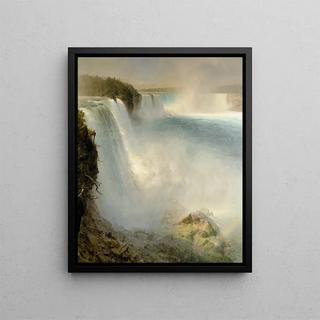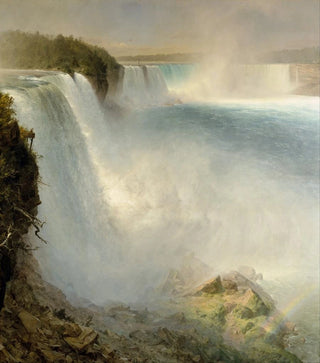Art print of Niagara Falls on the American side - Frederic Edwin Church | Art print


View from behind

Frame (optional)
Reproduction of the American side Niagara Falls - Frederic Edwin Church – Captivating introduction
Nature, in all its splendor, has always fascinated artists, but few have managed to capture it with as much power and delicacy as Frederic Edwin Church. His iconic work, "Reproduction of the American side Niagara Falls," offers a striking immersion into the grand spectacle of this natural wonder. The artist, a prominent member of the American Romantic movement, manages to transcend simple representation to evoke a profound emotional experience. Through this art print, the viewer is invited to feel the strength and majesty of the falls, while being transported to a world where nature and art meet harmoniously.
Style and uniqueness of the work
Church's work stands out for its meticulous technique and particular attention to detail. The nuances of light and shadow, as well as the vibrant color palette, create an almost tangible atmosphere. The falls, majestic and imposing, seem to come alive, while the surrounding vegetation adds a touch of softness to the scene. The artist uses bold perspectives to guide the viewer's gaze across the painting, which enhances the impression of vastness and grandeur. Every element, from the rocks to the clouds, is carefully arranged to create a balanced and dynamic composition. Church does not merely depict a landscape; he invites the viewer to immerse themselves in it, to feel the mist on their skin, and to hear the roar of the water.
The artist and his influence
Frederic Edwin Church, born in 1826, is one of the leading representatives of the Hudson River School, an artistic movement that celebrates the beauty of American landscapes. Influenced by travels and explorations, Church was able to incorporate elements of different cultures and traditions into his art. His interest in nature is not only aesthetic; it also reflects a concern for the preservation of these landscapes in the face of America's growing industrialization. Through his works, he paved the way for a new way of seeing and understanding nature, inspiring other artists to explore similar themes. His legacy endures, inspiring generations of creators to engage in reflection on the relationship between man and his environment.
A wall decoration of

Matte finish

View from behind

Frame (optional)
Reproduction of the American side Niagara Falls - Frederic Edwin Church – Captivating introduction
Nature, in all its splendor, has always fascinated artists, but few have managed to capture it with as much power and delicacy as Frederic Edwin Church. His iconic work, "Reproduction of the American side Niagara Falls," offers a striking immersion into the grand spectacle of this natural wonder. The artist, a prominent member of the American Romantic movement, manages to transcend simple representation to evoke a profound emotional experience. Through this art print, the viewer is invited to feel the strength and majesty of the falls, while being transported to a world where nature and art meet harmoniously.
Style and uniqueness of the work
Church's work stands out for its meticulous technique and particular attention to detail. The nuances of light and shadow, as well as the vibrant color palette, create an almost tangible atmosphere. The falls, majestic and imposing, seem to come alive, while the surrounding vegetation adds a touch of softness to the scene. The artist uses bold perspectives to guide the viewer's gaze across the painting, which enhances the impression of vastness and grandeur. Every element, from the rocks to the clouds, is carefully arranged to create a balanced and dynamic composition. Church does not merely depict a landscape; he invites the viewer to immerse themselves in it, to feel the mist on their skin, and to hear the roar of the water.
The artist and his influence
Frederic Edwin Church, born in 1826, is one of the leading representatives of the Hudson River School, an artistic movement that celebrates the beauty of American landscapes. Influenced by travels and explorations, Church was able to incorporate elements of different cultures and traditions into his art. His interest in nature is not only aesthetic; it also reflects a concern for the preservation of these landscapes in the face of America's growing industrialization. Through his works, he paved the way for a new way of seeing and understanding nature, inspiring other artists to explore similar themes. His legacy endures, inspiring generations of creators to engage in reflection on the relationship between man and his environment.
A wall decoration of
12,34 €






